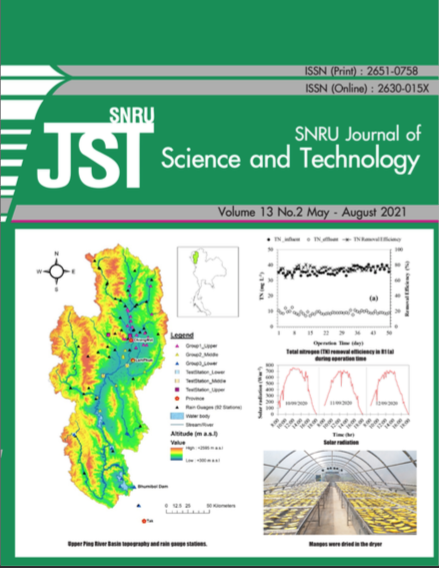Assessment of organics and nitrogen removal of aerobic granular sludge with the alternating operation of oxic – anoxic – oxic phases and different feeding mode in sequential batch reactor
Keywords:
aerobic granular sludge, sequencing batch reactor, nitrification and denitrification, step-feeding; oxic-anoxic-oxic phaseAbstract
Organic matters and nitrogen removal efficiencies from industrial wastewater were evaluated by the aerobic granular sludge (AGS) process with the alternative oxic/anoxic conditions and different feeding regime in Sequencing Batch Reactor (SBR). The experiment was carried out in two lab-scale SBR (R1 and R2) with the same alternation of oxic-anoxic-oxic (O-A-O). Specifically, R1 was applied for one-step feeding at the beginning of each cycle and R2 for two-step feeding with one more filling in anoxic phase. Our study results showed that AGS remained stable and maintained excellent settling properties with low SVI of 42 – 45 mL gTSS–1, and high sludge biomass of 7.46 – 7.53 g L–1 was retained in both reactors. Specific Oxygen Uptake Rate (SOUR) was 80.70 and 87.90 mgO2 gTSS–1 h–1 in R1 and R2 respectively that indicated the high biological activity of granular sludge. The high biomass retained and bioactivity of the organism in sludge leads to stable COD removal efficiency in both reactors about 88 – 91% during the experiment. In additional, total nitrogen (TN) removal efficiency of R2 (80.20 – 85.60%) was 13 – 15% higher than that of R1 (68.42 – 71.20%). Our study concluded that nitrogen removal via nitrification and denitrification was achieved in SBR operation with alternating of O-A-O, and two-step feeding was appropriated proposal for organic matters and nitrogen removal in single reactor. And step-feeding was an effective option in providing internal carbon source from wastewater as electron donor for denitrification in the anoxic phase instead of using external carbon source in SBR operation.
References
[2] S.J. Sarma and J.H. Tay, Aerobic granulation for future wastewater treatment technology: challenges ahead, Environ. Sci. Water Res. Technol. 4 (1) (2018) 9-15.
[3] M. Singh and R. K. Srivastava, Sequencing batch reactor technology for biological wastewater treatment: a review, Asia-Pacific J. Chem. Eng. 6 (1) (2011) 3-13.
[4] M.K. Jungles, J.L. Campos, and R.H. Costa, Sequencing batch reactor operation for treating wastewater with aerobic granular sludge, Brazilian Journal of Chemical Engineering. 31 (1) (2014) 27-33.
[5] J. Wan, Y. Bessière, and M. Spérandio, Alternating anoxic feast/aerobic famine condition for improving granular sludge formation in sequencing batch airlift reactor at reduced aeration rate., Water Res. 43 (20) (2009) 5097–5108.
[6] D. P. Cassidy and E. Belia, Nitrogen and phosphorus removal from an abattoir wastewater in a SBR with aerobic granular sludge, Water Res. 39 (19) (2005) 4817-4823.
[7] A. Jang, Y.H. Yoon, I. S. Kim, K.S. Kim, and P. L. Bishop, Characterization and evaluation of aerobic granules in sequencing batch reactor, J. Biotechnol. 105 (1) (2003) 71-82.
[8] S.S.Adav, D.-J.Lee, and J.Y.Lai, Biological nitrification-denitrification with alternating oxic and anoxic operations using aerobic granules, Appl. Microbiol. Biotechnol., 84 (6) (2009) 1181-1189.
[9] APHA, Standard Methods for the Examination of Water and Wastewater. Washington DC, 2005.
[10] N. D. Minh, Treatment of high-strength organic wastewater using an aerobic granular system with baffled membrane bioreactor, Ph.D. Thesis, Asia Institute of Technology-Thailand, 2006.
[11] M. T. Vives, SBR Technology for wastewater treatment: suitable operational conditions for nutrient removal, Ph.D. Thesis, University of Girona, Girona, Italia, 2004.
[12] Z. Song, Y. Pan, K. Zhang, N. Ren, and A. Wang, Effect of seed sludge on characteristics and microbial community of aerobic granular sludge, J. Environ. Sci. 22 (9) (2010) 1312-1318.
[13] T. T. P. Nguyen, V. P. Nguyen, T. B. H. Truong, and M. H. Bui, The formation and stabilization of aerobic granular sludge in a sequencing batch airlift reactor for treating Tapioca-processing wastewater, Polish J. Environ. Stud. 25 (5) (2016) 2077–2084.
[14] A. Val del Río et al., Aerobic granular SBR systems applied to the treatment of industrial effluents, J. Environ. Manage. 95 (2012) 88-92.
[15] B. Arrojo, A. Mosquera-Corral, J. M. Garrido, and R. Méndez, Aerobic granulation with industrial wastewater in sequencing batch reactors, Water Res. 38 (14–15) (2004) 3389-3399.
[16] A. Mosquera-Corral, M. K. de Kreuk, J. J. Heijnen, and M. C. M. van Loosdrecht, Effects of oxygen concentration on N-removal in an aerobic granular sludge reactor., Water Res. 39 (12) (2005) 2676–2686.
[17] Q. Feng, J. sun Cao, L. N. Chen, C. Y. Guo, J. yi Tan, and H. lian Xu, Simultaneous nitrification and denitrification at variable C/N ratio in aerobic granular sequencing batch reactors, J. Food, Agric. Environ. 9 (3–4) (2011) 1131-1136
[18] Metcalf and Eddy, Wastewater Engineering:Treatment and Reuse(4thed.).McGraw-Hill, 2004.
[19] F. Chen, Y.-Q. Liu, J.-H. Tay, and P. Ning, Operational strategies for nitrogen removal in granular sequencing batch reactor, J. Hazard. Mater. 189 (1–2) (2011) 342-348.
[20] X.H. Wang, L.X. Jiang, Y.J. Shi, M.M. Gao, S. Yang, and S.G. Wang, Effects of step-feed on granulation processes and nitrogen removal performances of partial nitrifying granules, Bioresour. Technol. 123 (2012) 375-381.









